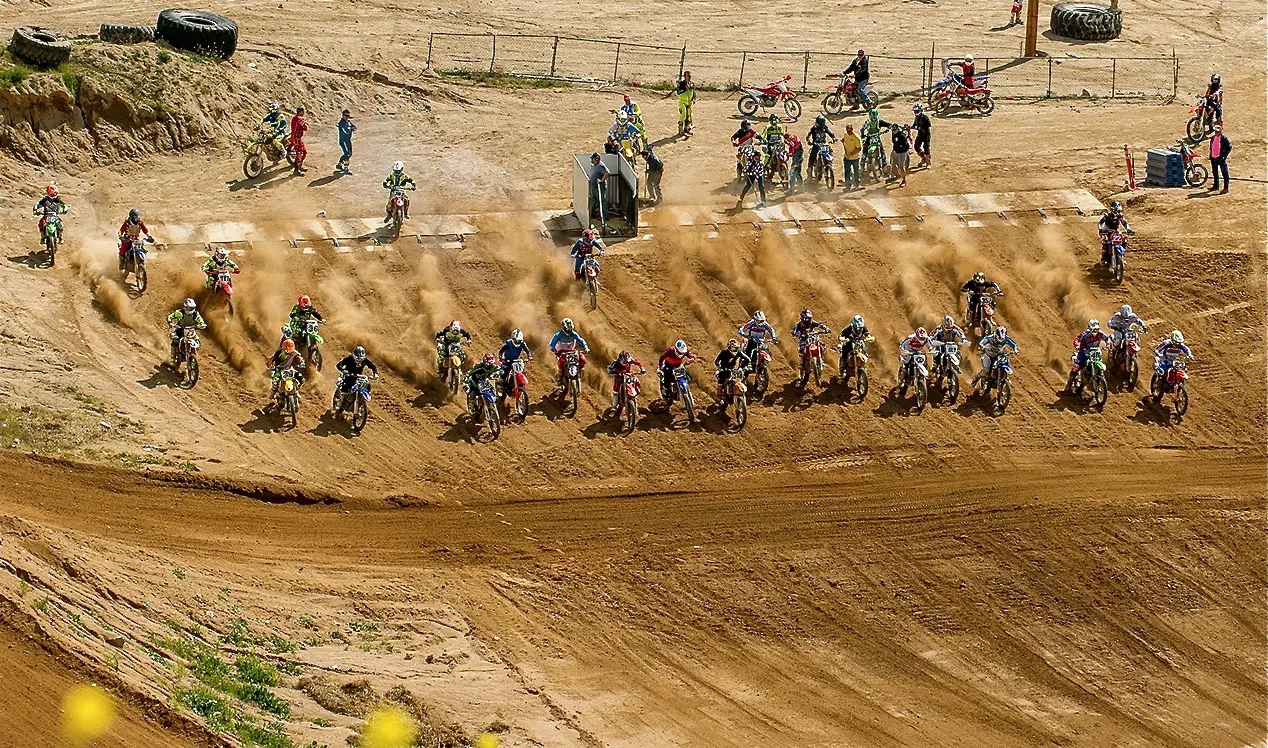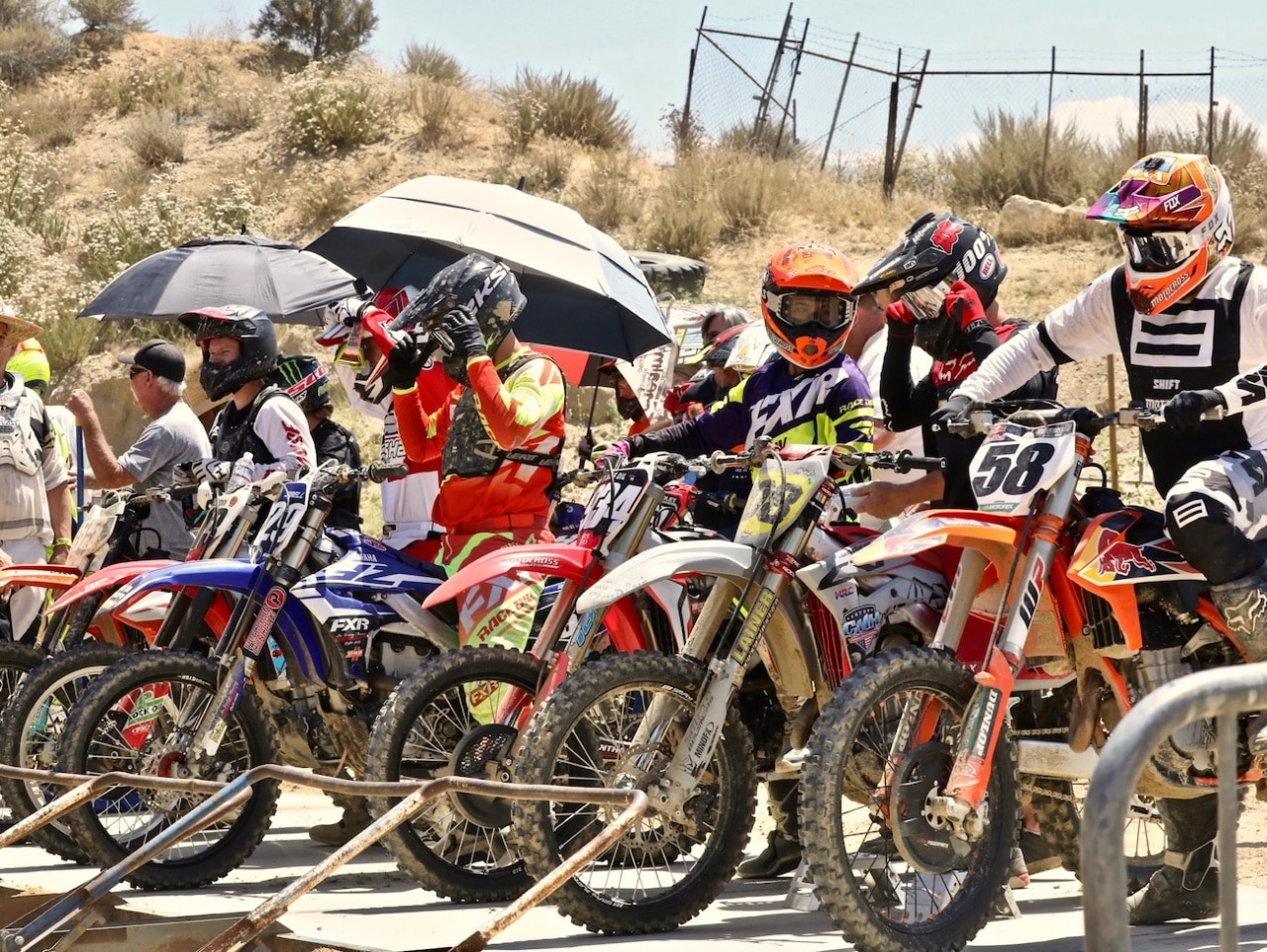TEN THINGS YOU NEED TO KNOW ABOUT STARTING ON CONCRETE
(1) Grit. Think of concrete starting pads as sandpaper, but not always heavy-grit paper. Sandpaper varies from ultra fine to extra coarse. The same goes for concrete. Each concrete starting pad has a different grit rating. Knowing the grit of a concrete starting pad is important for getting a good launch off the gate. The finer the concrete texture, the more weight needs to be placed on the rear wheel, the smoother the clutch actuation needs to be, and the more likely you are to spin the rear tire. Coarse finishes make it easier to get the traction you need, although your weight needs to be farther forward in case the rear tire hooks up too well.
(2) Rubber. The amount of traction you get can depend on the rear tire you’re using. Different rubber compounds, tread patterns and tire widths make a difference in how much traction you get. The greater the rear tire’s contact patch (120 versus 110), the more likely you are to get a solid launch (an example would be a street bike tire versus a dirt bike tire); however, the rubber compound has as much to do with getting bite on concrete as the tire width. Sand and Intermediate-compound tires have harder rubber than hardpack tires. Harder rubber compounds are more likely to spin than tackier, softer rubber. Most inexpensive tires on the market use harder compound rubber to increase durability. If you make specific choices for a concrete start, they may not be optimum on the actual racetrack. You wouldn’t want to use a softer-compound hardpack tire for the start and then have to hunt for traction in loamy dirt. You also wouldn’t want to use a wider 120 rear tire for the start and then struggle in ruts because of the tire’s squarish profile.
(3) New tread. Believe it or not, brand-new tires aren’t an advantage on concrete starts. Don’t be fooled by the look of brand-new knobs. Those sharp square edges on a new tire tend to break traction under a load. The edges need to be rounded off to get a better purchase on the concrete. That’s right, we’re telling you to burn the edges off of your brand-new knobs before the start. Yes, you will shorten the life of your new sneakers, but how badly do you want a good start?
(4) Slow heat. Have you ever started next to a guy who does a John Force-style top-fuel burnout on the concrete while waiting for the race to start? It’s like smoking six packs a day for a year. Doing a smoky burnout only heats the top few millimeters of the knobs, not the complete knob. A slow rotation burnout will heat more surface area than a drag-race smoker. Do short intervals rather than one long one. Be aware that if the tire gets too hot, you’ll end up starting on a gooey patch of melted rubber. Even worse, according to tire designers, if you heat your rear tire up more than 45 seconds before the gate drops, your tire will cool off before you can get any benefit from heating it up. Most tire gurus believe that spinning the rear tire just enough to clean the knobs and score the rubber is all you need to do.
(5) Don’t move. It doesn’t matter if you use the one-leg-up or two-legs-down method; just make sure to keep your position until you’re over the gate. If you bring your leg or legs up too soon, there’s a good chance your balance will fall to one side or the other. This will pitch the rear wheel out, and, instead of being propelled forward, your rear tire will slide sideways.
(6) Fingers. A hard habit to break when starting on concrete is letting the clutch out too quickly. You are in a hurry, and your brain tells you to dump the clutch and get going. Don’t listen to your brain. Feed the clutch out while the rear tire is on the cement, then dump it once on the dirt. A no-brainer way to slow down your clutch fingers is to use your three outer fingers on the lever. Most riders use their middle finger or index finger, but these fingers are too fast for their own good. When using the three outer fingers, it will take you longer to let out the clutch. This helps get traction to the ground.
(7) Loading up. Loading up is a technique used to take the slack out of the chain. This is done by holding the front brake as you slowly engage the clutch to engage the tranny, chain and rear sprocket. Many riders leave light pressure on the front brake until they clear the gate.
(8) Body position. Where you sit on the bike and where your torso is leaning control the distribution of weight to the rear wheel. Don’t try to get more traction by moving way back on the seat. Instead, sit 6 inches farther back, but keep your torso erect. That way you will center your weight on the bike. Don’t lean forward with your elbows up as on a dirt start. Instead, sit bolt upright and hinge your upper body forward or backward from your hips to find the sweet spot.
(9) Gear. Second gear is the universal choice for virtually every start, be it dirt or concrete; however, if the concrete is super slick or wet, click up to third, lean back and feather the clutch out. Most factory racers don’t use launch control. They depend on a talented left hand. But concrete starts, which AMA stars never see, are prime for launch control buttons.
(10) Feel it. You may be the kind of guy who goes to the practice track and spends all day refining his whip. Guess what? Jumping jumps isn’t half as important as getting the holeshot. Everybody on the track can jump the jumps, but only one person can get the holeshot. You need to practice your starts to be good at them. Repetition allows you to put all of the pieces together. Only by practicing starts can you try different body positions, weight shifts, numbers of fingers, gears, tire heat and launch control settings without paying the penalty of losing a race.







Comments are closed.